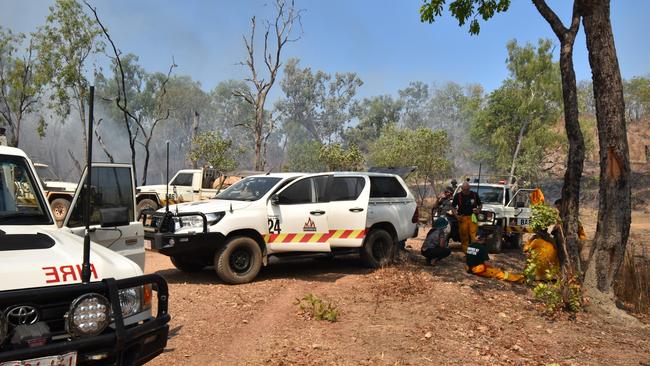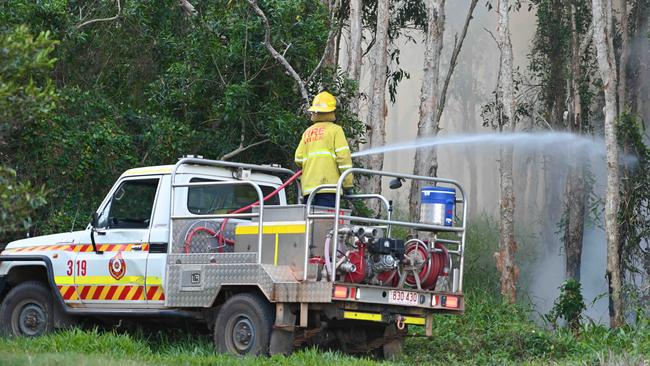‘Insidious’: Gamba grasses fuel shocker fire season for Top End
Wildlife advocates say animals “don’t stand a chance” when a gamba-fuelled bushfire sweeps through. Read why the weed is so devastating.
News
Don't miss out on the headlines from News. Followed categories will be added to My News.
This fire season has been a shocker for the Top End, and it’s not even over yet.
Bushfires NT’s volunteer brigades, which cover regions from Berry Springs to Douglas Daly and out to Point Stuart, have responded to 270 fires this season.
That’s up 36 compared to the figure recorded at the same date last year.
Alarmingly, it’s estimated 80 per cent of the fires were “suspiciously or intentionally lit” according to the Department of Environment, Parks and Water Security.
“There have been multiple incidents when fires are started at several locations in close proximity indicating the work of illegal fire starters,” a department spokesperson said.

“We have had quite a few fires that have required response over several days.
“Our experienced members have noticed that the fire behaviour has being more erratic and classed as extreme fire behaviour not expected for the weather of the day.
“Already this season we have done approximately 40 per cent more airdrops in support of ground assets to protect property than we did for the whole season last year.
“We have used close to 2,500,000 litres of water in fixed wing airdrops already.
“The vast majority of our fires in the Top End are associated with gamba grass.
“It burns up to eight times hotter than native grasses.”

Former CDU Conservation and Land Management lecturer Andrew Spiers agrees that fires are becoming harder to control with the spread of the notorious gamba grass.
Mr Spiers said mission grass and tully grass, two other prominent introduced species, were also increasing the fires’ intensity and spread according.
“People in the Top End aren’t used to intense fires, they’re used to fires that trickle around under the trees,” he said.
“We’re living in a fool’s paradise up here and it’s changing rapidly because of gamba.
“It can grow up to four metres high which raises the flame height and temperature of fires.
“That gives fireys a big problem as the fire can more readily jump over unburnt country (and) start in other places.

“The fires contribute immensely to the spread of the seed as well as it can travel for kilometres through the air.
“Mission grass, another species imported from Africa for pastoral use, certainly raises the fuel level of the bushland too.
“I have ash and cinders falling onto my property every day throughout the dry.”
Closer to the city, the Northern Territory Fire and Rescue Service has responded to 1651 bushfires so far this season.
The weed was a key election issue in this year’s federal election, with $9.8m pledged by Labor to combat its spread.
The Northern Territory government also allocated $525,000 towards gamba risk mitigation in this year’s Budget.
Mr Spiers, who has been fighting to eradicate the weeds on his Adelaide River property for 16 years, said it was not enough.
“The whole effort by the government is just a drop in the ocean compared to what’s needed,” he said.
“If gamba grass is not dealt with we will lose our savannah woodlands and they will be replaced with African grasslands.
“In fact, in some areas this has already happened.
“The trees are being killed as well as the frogs, possums, lizards and birds that use them for shelter.”
Darwin Wildlife Sanctuary founder Ally Szyc said native wildlife do not stand a chance when a gamba bushfire sweeps through.

“Unlike native grass fires, the wildlife we come across in the aftermath is either already dead or has to be euthanised,” she said.
“That’s because the flames are reaching the treetops and arboreal species that shelter there in a fire are getting caught.
“We only brought in four injured wildlife this year that managed to survive a fire but sadly three didn’t make it in the end.
“One northern brushtail possum we named Burnie suffered severe burns to her hands, feet and ears after a large fire.
“Thanks to a dedicated team of carers and vets she was released back into the wild months later after multiple surgeries.”

Humpty Doo resident Pauline Cass has witnessed the loss of wildlife year after year.
“When my block burned I was finding dead possums, bandicoots, pythons, lizards and even a dead wallaby as I searched the barren bush for survivors,” she said.
“It broke my heart when I found an endangered black footed tree rat that was still alive, huddled under pandanus roots and burnt almost beyond recognition.
“It died in my arms as I carried it to the car.”
NT property owners are legally required to control gamba grass on their properties.
A 15m wide gamba-free buffer zone must be maintained along all boundaries, driveways and properties.




